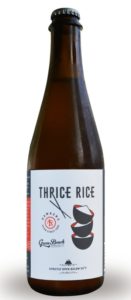Top 10 Brett Beers in America
This Top Ten List of Brett Beers is from the results of the U.S. Open Beer Championship, Great American Beer Festival, and World Beer Cup. Brett Beers vary in color and can take on the hues of added fruits or other ingredients. Horsey, goaty, leathery, phenolic and some fruity acidic character derived from Brettanomyces organisms may be evident, but in balance with other components of American Brett beers. Brett beers and sour beers are not synonymous.

1. Thrice Rice – Green Bench Brewing – Florida
2. 1904 – Brasserie Saint James – Nevada
3. (512) Wild Bear – (512) Brewing Co. – Texas
4. Crossed Eyed Lefty – Denver Beer Company – Colorado
5. Red Swingline IPA Primitif – Trinity Brewing – Colorado
6. Persica Wild Wild Brett – Crooked Stave Beer Project – Colorado
7. Pit Caribou Brett Session IPA – Microbrasserie Pit Caribou – Canada
8. Palomino – Barrel Aged – Forest & Main Brewing – Maine
9. Casey Brett Loves Mosaic – Casey Brewing and Blending – Colorado
10. Golden Ale – New Glarus Brewing Co. – Wisconsin
History of Brett Beers
Brettanomyces, often referred to as “Brett,” is a wild yeast with a storied history in brewing, first identified in the late 19th century for its role in imparting unique flavors to English ales. In 1889, Seyffert at Russia’s Kalinkin Brewery isolated a yeast from English beer that contributed its distinctive “English” taste, while in 1904, N. Hjelte Claussen at Denmark’s Carlsberg Brewery formally described Brettanomyces, naming it the “British fungus” for its association with aged stock ales, porters, and barrel-aged IPAs. These beers, stored in oak barrels, allowed Brett to slowly ferment residual sugars left by Saccharomyces yeast, producing complex, funky flavors like leather, fruit, and barnyard. This yeast, naturally present on fruit skins and in brewery environments, was integral to traditional British and Belgian styles like lambics, gueuzes, and Flanders red ales, where open fermentation invited its unpredictable influence, creating tart, earthy profiles revered in these regions.
In the modern era, particularly since the late 1990s, American craft brewers have embraced Brettanomyces, transforming it from a spoilage yeast into a deliberate tool for innovation. Pioneers like Vinnie Cilurzo of Russian River, Ron Jeffries of Jolly Pumpkin, and Tomme Arthur of The Lost Abbey experimented with Brett to replicate Belgian-style complexity, introducing 100% Brett-fermented beers that emphasized fruity esters over funk, such as tropical notes of pineapple and stone fruit. By the 2000s, Brett IPAs and saisons, like Port Brewing’s Mo Betta Bretta, gained popularity for their vibrant, hop-complementary profiles. Today, brewers use specific Brett strains from labs like White Labs and Escarpment, often in controlled fermentations or barrel-aging, to craft diverse styles from hoppy pale ales to mixed-culture sours, cementing Brett’s role as a cornerstone of craft beer creativity.
Top 10 Beers in America – Ales Lagers Specialty Barrel Aged